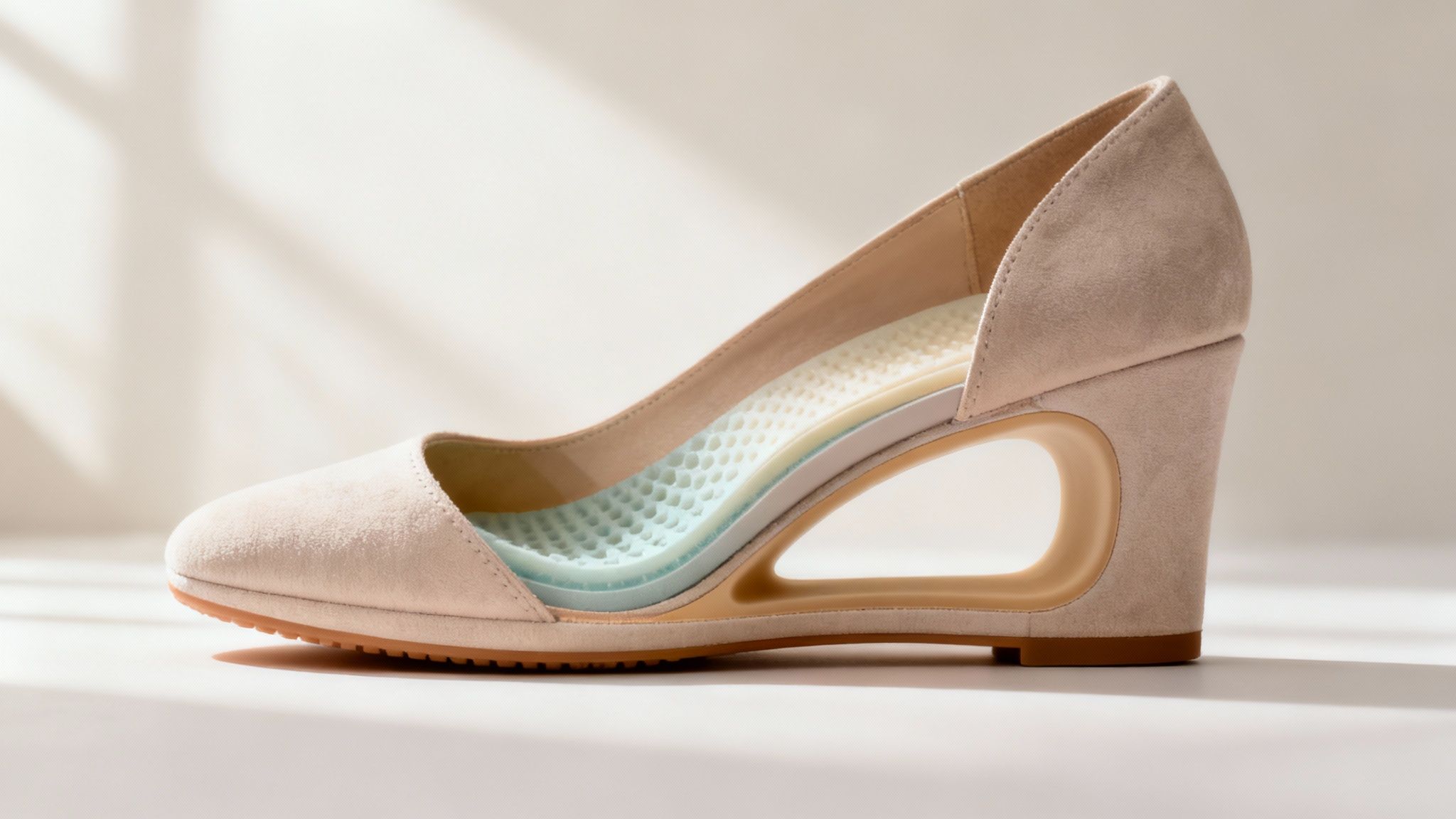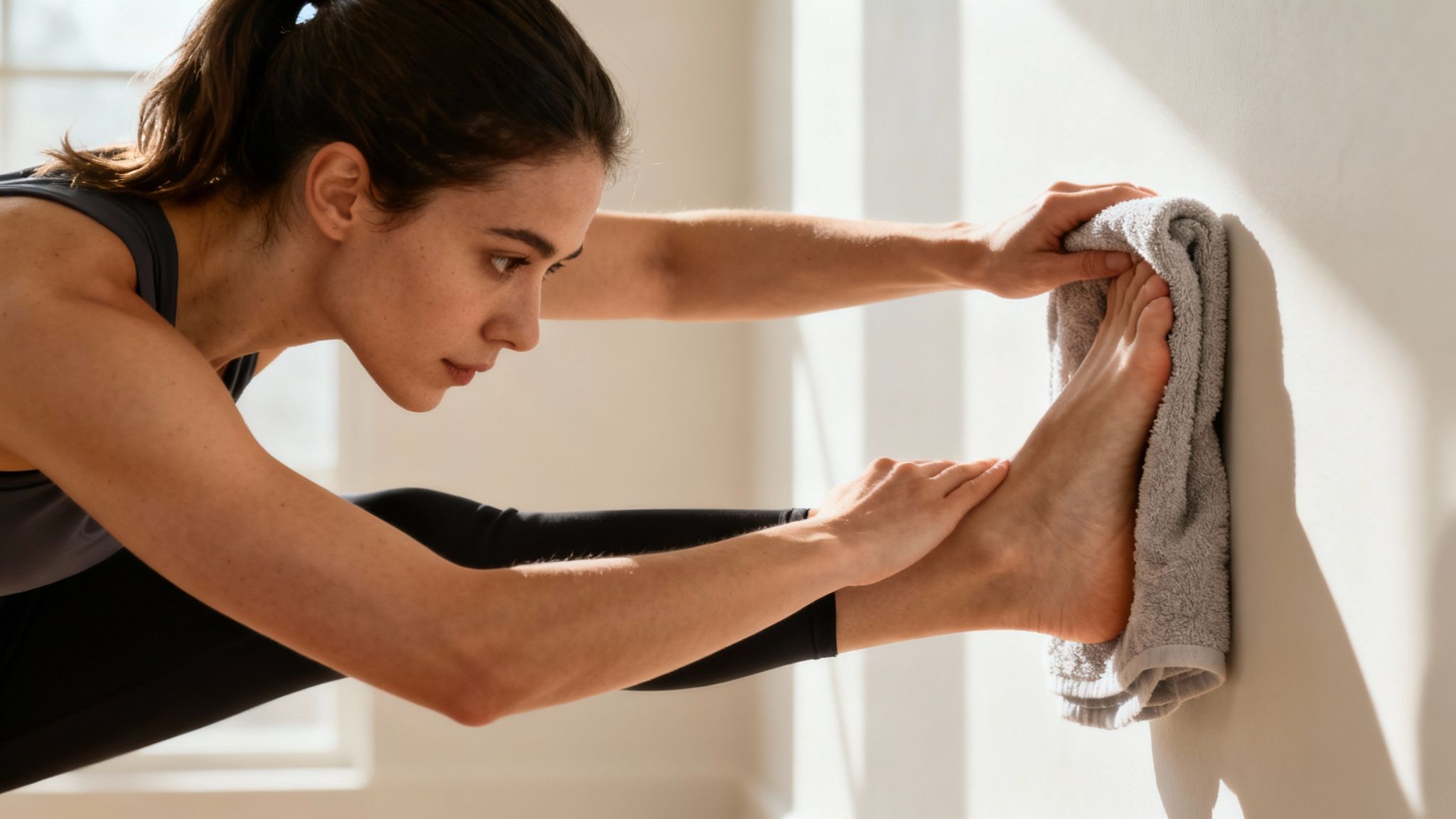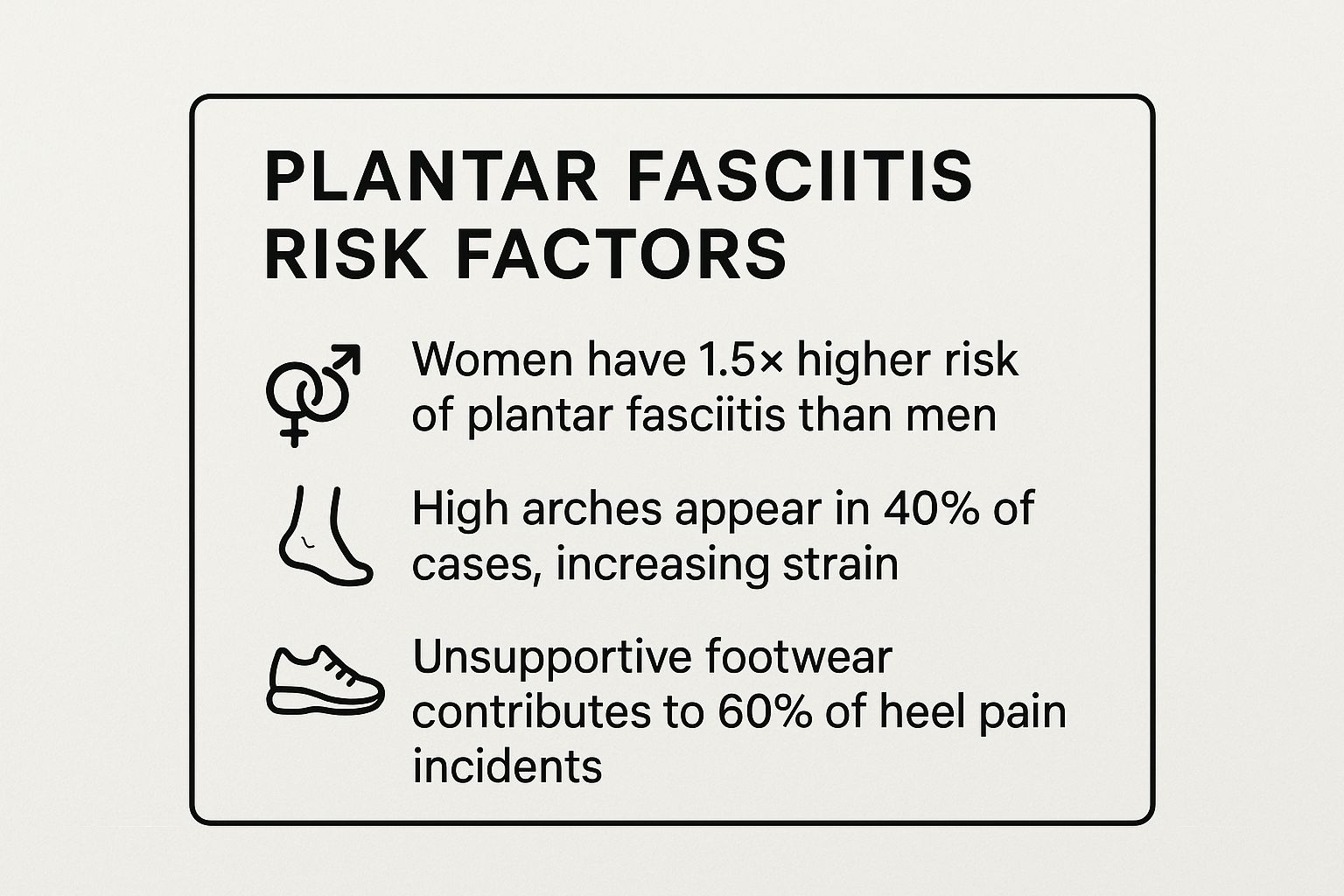Best Plantar Fasciitis Shoes for Women
- Flourish Everyday Health And Fitness

- Oct 10
- 10 min read
Updated: Oct 14
If you're dealing with plantar fasciitis, you know that every step can feel like a battle. I usually stretch mine out well in the morning and I am pretty sure it was due to worn out trainers.
The right pair of shoes can be a game-changer, helping you reclaim your comfort. This guide is your roadmap to understanding how the right footwear can not just soothe heel pain but also prevent it from returning.
We’re going to focus specifically on the best plantar fasciitis shoes for women, digging into everything you need to know, from the causes of this condition to the features that offer real relief.

In This Guide
Understanding Plantar Fasciitis in Women
To find the right solution, you must understand the problem. The plantar fascia is a thick ligament running along the bottom of your foot, from your heel to your toes. It supports your arch and acts as a shock absorber. When this ligament is overstretched, it becomes inflamed, causing the sharp, stabbing pain known as plantar fasciitis, especially with the first steps in the morning.
What Causes This Painful Condition
Plantar fasciitis is typically the result of accumulated stress and tiny tears in the ligament over time.
Foot Mechanics: High arches or flat feet can cause uneven weight distribution, putting extra tension on the plantar fascia.
Increased Activity: A sudden jump into a new running routine or a job that requires standing all day can overwhelm the ligament.
Unsupportive Footwear: Wearing shoes with flimsy arch support, minimal cushioning, or stiff soles is a major contributor. Fashion flats or high heels force the plantar fascia to work overtime.
This infographic highlights why women often bear the brunt of this condition.
The combination of foot structure and common shoe choices creates a higher risk for women.
Why Women Are Often More Susceptible
Beyond the usual causes, several factors make women especially prone to plantar fasciitis. Fashion often prioritizes style over function. Years of wearing high heels can shorten the Achilles tendon, while flats offer zero support. Additionally, hormonal changes during pregnancy can loosen ligaments, making the plantar fascia more vulnerable to strain, while extra weight adds more pressure.
The link between footwear and foot health is undeniable. The market for plantar fasciitis treatments is growing rapidly, reflecting how common this problem has become, particularly for women.
The global market for treatments, including specialized plantar fasciitis shoes for women, was valued at around USD 1.59 billion in 2025 and is projected to reach USD 2.14 billion by 2030 (Verified Market Research, 2023). This growth is fueled by the number of women dealing with this condition. Clinical insights show that the right shoes can ease heel pain by 30-50%, especially when combined with physical therapy. You can discover more insights about the plantar fasciitis shoe market and its trends.
What to Look for in a Supportive Shoe
When dealing with stabbing heel pain, you learn that not just any shoe will do. The right footwear is less about the brand and more about a specific set of features that work together to protect your feet. Knowing what to look for transforms you from a hopeful shopper into an informed buyer.

The right shoe acts like a helping hand for your overstretched plantar fascia, holding it in its natural position to reduce strain. This is where solid arch support comes into play, it stops your arch from collapsing, a main culprit behind the strain.
Building the Foundation with Arch and Heel Support
The core of any good plantar fasciitis shoe is its structure. Proper support is what allows your foot to begin the healing process.
First, you need excellent arch support. This is non-negotiable. It helps distribute your body weight evenly across your foot instead of concentrating it on your heel, taking pressure off the plantar fascia.
Secondly, and just as critical is a deep, supportive heel cup. This part of the shoe cradles your heel, locking it securely in place to prevent sliding and ensure proper alignment. This stability minimizes the side-to-side motion that can irritate an inflamed fascia.
A shoe's architecture is its promise of support. Without a firm midsole and a snug heel counter, even the most cushioned shoe will fail to provide lasting relief. The combination of structure and softness truly makes a difference.
Cushioning and Rigidity Where It Counts
While support provides structure, cushioning delivers immediate relief. Think of walking on hard concrete versus a plush mat, the mat absorbs the shock, and that's what good cushioning does for your feet.
Generous Cushioning: Look for shoes with ample padding, especially in the heel. This acts as a shock absorber, softening the impact of each step.
Firm Midsole: A shoe that bends too easily in the middle is a red flag. A great shoe for plantar fasciitis should be rigid through the arch. Test it by holding the shoe by the heel and toe and trying to twist it; it should feel sturdy.
Proper Flex Point: While the middle should be firm, the shoe must bend where your foot naturally does—at the ball of the foot. This allows for a smooth, natural gait without stressing your arch.
These features are vital for both everyday and athletic shoes, overlapping with what makes for the best running trainers and their key support features.
Essential Shoe Features for Plantar Fasciitis Relief
Feature | Why It Helps | What to Look For |
|---|---|---|
Arch Support | Distributes pressure evenly and prevents the arch from collapsing, reducing strain on the plantar fascia. | A contoured footbed that matches your natural arch. Avoid completely flat insoles. |
Deep Heel Cup | Cradles the heel to provide stability, control motion, and improve alignment. | A firm, well-defined cup that hugs the back of your foot snugly. |
Ample Cushioning | Absorbs shock from walking on hard surfaces, providing immediate pain relief. | Thick padding, especially in the heel and forefoot. Look for materials like EVA foam or gel. |
Firm Midsole | Prevents the shoe from flexing in the arch, which protects the plantar fascia from overstretching. | A shoe that resists twisting and doesn't easily bend in the middle. |
Correct Flex Point | Allows the foot to roll through a natural stride without straining the arch. | The shoe should bend easily at the ball of the foot, not in the middle of the arch. |
Rocker Sole | Guides the foot through a natural rolling motion, reducing pressure on the heel and arch. | A noticeably curved, thicker-than-average sole from heel to toe. |
The Added Benefit of a Rocker Sole
An effective but often overlooked feature is a rocker sole. A shoe with a rocker bottom has a thick, slightly curved sole, like the legs of a rocking chair. This design helps your foot "rock" forward from heel to toe as you walk. This rolling motion significantly reduces pressure on both your heel and arch, encouraging a more fluid stride and minimizing how much your foot has to flex.
Top-Rated Shoe Brands for Lasting Comfort
Finding the right supportive shoe can feel overwhelming, but a few brands consistently receive high praise from podiatrists and users. These companies have built their reputations on creating plantar fasciitis shoes for women that blend therapeutic design with wearable styles.
The market for these specialized shoes is growing because so many people need them. Plantar fasciitis impacts about 10% of the population (Cleveland Clinic, 2023). Brands like Hoka, Vionic, and Brooks lead the industry by incorporating orthotic principles into fashionable, everyday footwear.
Hoka is known for its "maximalist" approach, packing an incredible amount of soft, bouncy cushioning into its shoes. This super-thick midsole excels at absorbing shock, giving your heel a break from the constant pounding of each step. Many Hoka models also feature a Meta-Rocker sole, a curved bottom that helps your foot roll smoothly, easing strain on the plantar fascia.
Signature Technology: Maximal cushioning and Meta-Rocker sole.
Best For: Women seeking maximum shock absorption for running, walking, or standing all day.
Popular Models: The Hoka Bondi is a favorite for its plush feel. The Clifton offers a lighter design that is still packed with cushion.
Vionic was co-founded by a podiatrist, and that medical insight is evident in their shoes. Their Vio-Motion Support technology offers three-zone comfort targeting your heel, arch, and forefoot. What sets Vionic apart is its commitment to style. They offer everything from sneakers and slip-ons to sandals and work-appropriate flats, all with crucial built-in orthotic support.
Vionic's philosophy is simple yet effective: design footwear that hugs your arches and supports your body's natural alignment from the ground up, making comfort a seamless part of your daily style.
Brooks is a giant in the running community, known for its deep understanding of biomechanics. This focus makes their shoes a fantastic option for women with plantar fasciitis, even non-runners. Their shoes are built to provide stability and control excessive foot motion, a common cause of heel pain. Many Brooks shoes, like the popular Adrenaline GTS, use their GuideRails technology. These act like bumpers, keeping your foot moving in its ideal path and preventing it from rolling too far inward or outward, which can stress the plantar fascia.
Other Brands Worth a Look
While Hoka, Vionic, and Brooks are top contenders, other brands offer excellent options:
ASICS: Known for its GEL technology, which provides fantastic shock absorption. The GEL-Nimbus is a highly cushioned, neutral shoe often recommended for plantar fasciitis.
New Balance: A great option for those needing various widths. The Fresh Foam X 1080v series is loved for its soft cushioning and accommodating fit.
Saucony: Blends responsive cushioning with a solid, supportive structure. The Triumph model feels plush while providing necessary arch support.
How to Choose the Perfect Pair for Your Needs
Finding the right plantar fasciitis shoes for women is a personal journey. Your foot shape, lifestyle, and daily activities all play a role. This guide aims to empower you to make a smart choice that supports your feet. A key tip is to try on shoes in the late afternoon or evening, as feet naturally swell during the day.
The In-Store Fit Test
Before buying, perform a quick physical check. These simple tests help you identify a shoe with the solid structure needed to protect your plantar fascia.
First is the flex test. Hold the shoe by the heel and toe and try to bend it in half. A supportive shoe will only bend at the ball of the foot. If it folds in the middle of the arch, it's too flimsy.
Next, perform the twist test. Grab the shoe at both ends and try to wring it like a towel. A well-made shoe will resist twisting, indicating a firm, stable midsole that will prevent your foot from rolling and reduce strain.
Matching Your Shoes to Your Lifestyle
The ideal shoe for a runner is different from what a teacher needs for standing all day. Match your shoes to your life.
For Everyday Wear: A versatile walking shoe or casual sneaker with excellent arch support and cushioning is ideal. Brands like Vionic offer styles that look good without sacrificing orthopedic benefits.
For the Workplace: If you're on your feet for hours, maximum cushioning and a stable foundation are essential. For more ideas, see our ultimate guide to comfortable shoes for women who stand all day.
For Athletic Activities: High-impact exercise requires serious shock absorption and stability. Brands like Brooks and Hoka design athletic shoes to absorb impact and control foot motion, preventing flare-ups.
For Summer and Warm Weather: Avoid flimsy flip-flops. Look for sandals with contoured footbeds, deep heel cups, and adjustable straps to give your arches the support they need.
Choosing the right shoe isn’t about one miracle pair. It’s about building a smart collection of supportive options for different parts of your life, ensuring your feet are protected no matter what.
Complementary Therapies for Heel Pain Relief
The right pair of plantar fasciitis shoes for women is your strongest defense, but it's only one piece of the puzzle. To truly heal, you must also address the underlying tightness and inflammation. Combining supportive footwear with key therapies provides a complete toolkit for managing pain.

This holistic approach is crucial as chronic foot problems rise. The orthopedic footwear market is growing, partly due to conditions like plantar fasciitis that disproportionately affect women (Allied Market Research, 2021). You can read more research on the orthopedic shoe market.
Stretches and Orthotics for Added Support
Simple, targeted stretches can make a significant difference. Gently stretching your calf muscles and the plantar fascia helps release tension. A consistent morning routine can dramatically reduce that sharp first-step pain. For post-workout ideas, see our guide to a smarter post-run stretching routine.
Orthotic inserts can also be a game-changer, providing a more custom level of support.
Over-the-Counter (OTC) Inserts: These are widely available and offer excellent arch support and heel cushioning for many people.
Custom Orthotics: For more specific needs, a podiatrist can create inserts molded to your unique foot shape, offering the highest level of corrective support.
When to Seek Professional Help
Supportive shoes and at-home therapies are often sufficient. However, if your pain persists for several weeks, worsens, or significantly impacts your life, it's time to see a professional. A podiatrist or physical therapist can provide a clear diagnosis, rule out other issues, and create a personalized treatment plan.
Common Questions Answered
Finding the right shoes for plantar fasciitis can bring up many questions. Here are straightforward answers to common queries.
How Quickly Will I Feel Relief?
While some women feel immediate improvement, it usually takes a few weeks of consistent wear to notice a significant reduction in pain. Supportive shoes work by reducing daily strain on the plantar fascia, allowing it to heal. Pairing your new shoes with gentle stretches can help speed up the process. The goal is cumulative relief; each day you wear supportive shoes, you break the cycle of re-injury.
Can I Use My Own Orthotics in These Shoes?
Yes, in most cases. The best brands design shoes with removable insoles, allowing you to swap them for your custom or over-the-counter orthotics. This feature enables a personalized level of arch support and alignment, which is crucial for stubborn heel pain. Always check if the insoles are removable before purchasing.
Are There Any Stylish Options?
Absolutely. The days of choosing between comfort and style are over. The supportive footwear market has evolved, and brands now offer fashionable shoes with essential orthopedic features. Brands like Vionic, Aetrex, and Dansko provide chic sandals, stylish boots, and elegant dress shoes that deliver the support your feet need without compromising your personal style.
References
Allied Market Research. (2021). Orthopedic Shoes Market by Application, End User, and Distribution Channel: Global Opportunity Analysis and Industry Forecast, 2021–2030.
Cleveland Clinic. (2023). Plantar Fasciitis.
Verified Market Research. (2023). Plantar Fasciitis Treatment Market Size And Forecast.
At Flourish-Everyday, we're all about guiding you to the best footwear and wellness info to keep you active and feeling great. Take a look at our curated picks and expert advice to find your perfect fit today. https://www.flourish-everyday.com


Comments